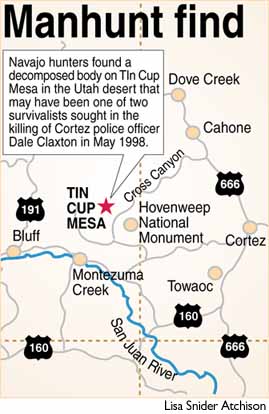|
Hunters find body thought to be fugitive gunman |
Nov. 2, 1999
ANETH, Utah – The skeletal remains of a man believed to be one of three fugitives who gunned down a Cortez police officer more than a year ago were discovered on a bluff northwest of Hovenweep National Monument, authorities said Monday. The skeleton, clad in camouflage fatigues with seven pipe bombs located around it, was found by deer hunters Sunday near Tin Cup Mesa, a rocky bluff overlooking a section of Cross Canyon northwest of Cortez, the focus of much of the manhunt in 1998. The hunters discovered the remains under a cedar tree shortly after finding a backpack containing a rain jacket, said San Juan County, Utah, Sheriff Mike Lacy. A .308-caliber FN-FAL rifle similar to the one that was used in the shooting death of Cortez police officer Dale Claxton was found beside the body, Lacy said. An empty 9mm Glock handgun was also found beside the body, he said. Lacy said he is certain the body is that of either Jason Wayne McVean, 28, of Durango, or Alan "Monte" Pilon, 32, of Dove Creek, the two survivalists who have been missing for more than a year since they disappeared into the desert canyons after allegedly killing Claxton on May 23, 1998, in Cortez. The third suspect, Robert Mason, 26, of Durango, was found dead outside of Bluff, Utah, on June 4, 1998. Authorities said Mason committed suicide by shooting himself with a 9 mm Glock handgun shortly after wounding a Utah sheriff’s deputy. The skeleton found Sunday was wearing a bullet-proof vest and appeared to have been torn apart by wild animals, Lacy said. The skull was in two pieces, and many of the bones were strewn about the area, he said. A Kevlar helmet was sitting on top of a packed tent nearby, he said. Lacy said authorities had not determined the identity of the skeleton. The remains were sent to the Utah Medical Examiner’s Office in Salt Lake City on Monday for identification through dental records. That identification could take three days or more, Lacy said. A search of the area around the skeleton failed to uncover the remains of anyone else, Lacy said. No notes were found with the body, he said. Lacy said the body appeared to have been on the rocky bluff for more than a year. The person’s boots were relatively intact, indicating that the person had not walked very far in them, he said. "The location of the body, the physical evidence, and other factors lead me to believe that the fugitive died within a few days of the beginning of the manhunt," Lacy said. There were no obvious signs of gunshot wounds or other wounds on the bones, Lacy said. Jane Quimby, spokeswoman for the FBI, said a case agent from Denver was being sent to help with the investigation, along with FBI agents from Salt Lake City. "The clothing and items lead us to believe it was one of the suspects involved in the murder of the officer in Cortez, Colorado," she said. From the bluff, a person could easily have watched Cross Canyon, Squaw Canyon, and a dirt road that passes by some nearby oil facilities, Lacy said. Two Montezuma County sheriff’s deputies were wounded in the high-speed chase that immediately followed Claxton’s shooting – a chase that ended when the suspects abandoned a stolen flatbed at the edge of Cross Canyon. The skeleton was about two miles northwest of where the flatbed was abandoned, Lacy said. Lacy said that because the skeleton was in such a state of decomposition, he feared that investigators might never know how the person died on Tin Cup Mesa. "I don’t know, we might not ever know for sure the cause," he said. The manhunt for the fugitives included more than 500 searchers and spanned six states, including reported sightings in Wyoming and Kansas that later turned out to be false. Navajo searchers also were called in as police combed canyons and sparse scrub in Arizona, Utah, Colorado and New Mexico. Residents said they believed the two missing men were getting help from other survivalists in the area. Hikers in remote regions of southeastern Utah and western Colorado reported seeing campfires and clandestine meetings in the desert, but police found only smoldering embers, empty beer cans and cigarette butts. Lacy said searchers had been in the area where the skeleton was found "hundreds of times," but said the dense vegetation made it impossible to search every foot of the rugged terrain. Although the body has yet to be confirmed as that of one of the fugitives, Lacy and Cortez Assistant Chief Russell Johnson both said that they were certain it was one of the men wanted for Claxton’s death. "We were looking for two (suspects)," Johnson said. "Now we believe we’re only looking for one, and that helps. We believe we’ve gotten two of the three. We need a third one to put a closure to this." Angel Sanders, 38, who has lived in Cortez most of her life, expressed relief that at least one of the suspects apparently has been located. "That sounds like him," she said after she learned he was wearing a flak jacket and was surrounded by pipe bombs. She said the community still has not gotten over the slaying and aftermath, and said people are still worried that the third suspect may still be roaming the area. "Hopefully, they’ll find the other one the same way," she said. The Associated Press contributed to this report. |
|
Contents
copyright © 1999, the Durango Herald. All rights reserved. |
|
 By Joshua Moore
By Joshua Moore